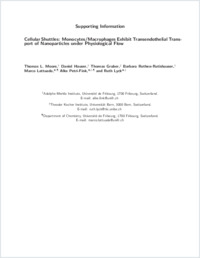Cellular shuttles: monocytes/macrophages exhibit transendothelial transport of nanoparticles under physiological flow
- Moore, Thomas L. Adolphe Merkle Institute, Université de Fribourg, Switzerland
- Hauser, Daniel Adolphe Merkle Institute, Université de Fribourg, Switzerland
- Gruber, Thomas Theodor Kocher Institute, Universität Bern, 3000 Bern, Switzerland
- Rothen-Rutishauser, Barbara Adolphe Merkle Institute, Université de Fribourg, Switzerland
- Lattuada, Marco Department of Chemistry, Université de Fribourg, Switzerland
- Petri-Fink, Alke Adolphe Merkle Institute, Université de Fribourg, Switzerland - Department of Chemistry, Université de Fribourg, Switzerland
- Lyck, Ruth Theodor Kocher Institute, Universität Bern, 3000 Bern, Switzerland
-
07.06.2017
Published in:
- ACS Applied Materials & Interfaces. - 2017, vol. 9, no. 22, p. 18501–18511
English
A major hurdle in the development of biomedical nanoparticles (NP) is understanding how they interact with complex biological systems and navigate biological barriers to arrive at pathological targets. It is becoming increasingly evident that merely controlling particle physicochemical properties may not be sufficient to mediate particle biodistribution in dynamic environments. Thus, researchers are increasingly turning toward more complex but likewise more physiological in vitro systems to study particle–-cell/particle–system interactions. An emerging paradigm is to utilize naturally migratory cells to act as so-called “Trojan horses” or cellular shuttles. We report here the use of monocytes/macrophages to transport NP across a confluent endothelial cell layer using a microfluidic in vitro model. With a custom-built flow chamber, we showed that physiological shear stress, when compared to low flow or static conditions, increased NP uptake by macrophages. We further provided a mathematical explanation for the effect of flow on NP uptake, namely that the physical exposure times of NP to cells is dictated by shear stress (i.e., flow rate) and results in increased particle uptake under flow. This study was extended to a multicellular, hydrodynamic in vitro model. Because monocytes are cells that naturally translocate across biological barriers, we utilized a monocyte/macrophage cell line as cellular NP transporters across an endothelial layer. In this exploratory study, we showed that monocyte/macrophage cells adhere to an endothelial layer and dynamically interact with the endothelial cells. The monocytes/macrophages took up NP and diapedesed across the endothelial layer with NP accumulating within the cellular uropod. These data illustrate that monocytes/macrophages may therefore act as active shuttles to deliver particles across endothelial barriers.
- Faculty
- Faculté des sciences et de médecine
- Department
- Département de Chimie
- Language
-
- English
- Classification
- Biological sciences
- License
- License undefined
- Identifiers
-
- RERO DOC 288915
- DOI 10.1021/acsami.7b03479
- Persistent URL
- https://folia.unifr.ch/unifr/documents/305497
Other files
Statistics
Document views: 68
File downloads:
- lat_csm.pdf: 198
- lat_csm_sm.pdf: 99

